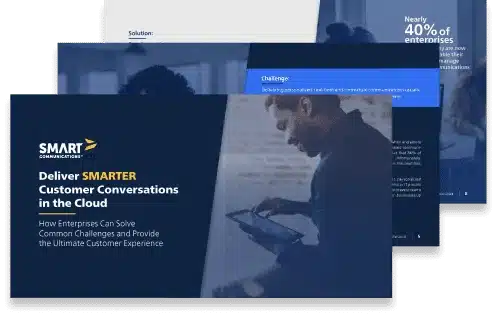Outsourcing Customer Communications: Balancing Cost, Control, and Consistency

By Scott Draeger, SVP of Product Marketing and Vertical Solutions at Smart Communications
When organizations grow to a certain size, new managers and external consultants often suggest outsourcing business processes that are not directly connected to the primary product or service offering. As a result, some organizations consider outsourcing customer communications. At the highest level, leadership teams may view the design, composition, production, and delivery of customer communications as a “non-core activity” that could be more efficiently managed by a specialized firm.
However, in the context of today’s customer experience (CX) landscape, reconsidering your sourcing strategy involves making tradeoffs that impact how you use your brand voice and communicate with customers. As the bar for CX continually raises, selectively outsourcing customer communications can create challenges in maintaining consistency throughout the customer lifecycle.
To make informed decisions, it’s essential to evaluate outsourcing through the lens of cost, control, and consistency. If not managed carefully, you risk losing control over your organization's image, intellectual property, and ability to communicate effectively and efficiently.
Evaluating Cost Implications of Outsourcing Customer Communications
Outsourcing customer communications has both obvious and hidden cost implications. When cost reduction is the primary driver for outsourcing customer communications, it may seem logical for a management task force, a finance team, or the C-suite to consider outsourcing customer communications. However, if this group lacks a full understanding of the organizations’ customers, prospects, partners, and other stakeholders; they may overlook critical cost factors.
Globally, the price of producing and delivering physical communications has been rising faster than inflation as mail volumes decline due to the adoption of faster and cheaper digital channels. In the United States, postage costs have increased 38% in the past ten years1. Since 2020, paper prices have increased 34%2. The fluctuation of input costs results in price risks to your communications that you cannot control. A long-term contract with an outside firm may obligate you to cover rising costs for ink or toner, paper, postage, and envelopes over time even as your customers’ preference for paper decreases over time. According to Treeline Research, enterprises will accelerate print suppression programs when a first-class stamp costs $0.88, which will likely happen within two years.
Additionally, the structure of your outsourcing contract matters significantly, especially when it comes to design work. Service providers handle design efforts in different ways: some may include initial design and migration work in exchange for a multi-year commitment, while others may charge separately for each design-related task. The more design work that’s bundled into the contract, the more the vendor is motivated to minimize the scope and frequency of changes. On the other hand, if design work is charged a la carte, the vendor has an incentive to suggest frequent changes.
The model that you use with your vendor has implications for both expense and flexibility now and in the future. Production and delivery costs can fluctuate wildly, and after a complex communication design is implemented, it may take months or years to change to switch vendors. If you rebrand frequently, work in an industry with rapidly changing regulations, or frequently acquire businesses; you could neglect to accurately forecast significant design costs into your sourcing strategy. If you engage multiple vendors for separate solutions, these design costs will be incurred for each vendor and each project you outsource.
Need help convincing multiple stakeholders that it’s time for a new CCM solution? Read ‘Building a Business Case for Change: How to Secure Stakeholder Buy-In When Purchasing Enterprise Customer Communicaitons Management (CCM) Software’
The Hidden Costs of Outsourcing Communications: Overhead and Quality Control
Outsourcing customer communications is rarely a singular decision for an organization. Sales, Operations, and Marketing budgets usually have different owners with separate decision-making authority. This can result in fragmented sourcing strategies, where different divisions make independent decisions about quality, price, and the outsourcing partner’s role in customer interactions.
If your sourcing strategy empowers each department to make these decisions in isolation, you may find that the effort required to coordinate, review, and manage these partnerships outweighs the expected savings. Production minimums and technology limitations can lock you into solutions that do not align with current customer preferences.
You need to fully understand the internal costs associated with design, content maintenance, project management, and approvals. While many service providers have deep experience in production, they may not understand the nuances of your communications. You’ll be required to review additional design iterations, absorb extra approval steps, and schedule internal reviews to ensure that the design updates are accurate and in production at the right time. Your internal effort may require more work and quality control as you train your vendor on the nuances of your industry and organizational voice.
Sophisticated customer communications management solutions provide a single template design so you can generate output for many channels. As your production needs change, the same application that makes a customer communication in print one month can generate that same communication digitally the next month. This offers your organization options to control production costs while also reducing design and management costs. For example, Smart Communications’ cloud-native Customer Communications Management (CCM) and Interaction Experience Management (IXM) technologies can be provisioned in under two hours, are built on reliable AWS infrastructure, and require no hardware or infrastructure investments.
Learn more about this emerging market segment focused on technologies that facilitate seamless customer interactions across digital channels.
Protecting Intellectual Property When Partnering with Outsourcers
If you've run the numbers, and included the risk of increasing production costs, increasing postal costs, design fees, and management costs, you may believe that your business case is solid. Let’s consider the intellectual property (IP) behind your customer communications. Once you work with an outsource provider, you lose some control of your communications-related IP.
Your vendor will translate your application’s words, images, charts, tables, and business rules into designs within the vendor’s chosen CCM system(s). Depending on your arrangement with the vendor, you may or not retain rights to the translation of your communications into CCM designs. Even if you have access to the IP, it is probably a moot point, as the applications will be built with software you do not have and processed by systems you do not need.
The vendor may incorporate internal applications that transform data, convert images, translate legacy formats, add production tracking, or other pre and post processing operations. Large service providers often standardize data layouts to create applications that are most efficient in their own production environment. Any software and systems used for these purposes are generally not part of your arrangement. Even if you were to receive the application’s source files, you would need to obtain a similar version of the software, strip out the proprietary production systems, remap the data, and purchase access to a CCM platform that was not chosen based on your needs.
In late 2023, many organizations in the UK found out that their service provider had gone into administration after their holding company, OSG Holdings, went through a bankruptcy process. This placed their clients in a difficult position, as their communication-related IP had changed ownership. The new owner, Paragon, has a great reputation, so the work would ultimately go to a reputable vendor.
These impacted clients did not negotiate their contracts with the new owner. They did not have a chance to security audit their operations. As a result, one of their clients on a ten-year contract made the decision to proactively switch customers to online statements. This likely caused considerable disruption to the client - ramping up online statement volume, managing infrastructure, and bringing new types of work to a new channel.
A Smart Approach to Retaining Control of Your Communication IP
With Smart Communications, organizations design applications for omnichannel delivery. Then, they often partner with service providers who use their high-speed production facilities to print, process, finish, and mail communications at scale.
Smart organizations find great partners to produce the communications, while keeping control of the IP represented by their communications. This treats the IP related to communications appropriately as a core activity, while sending out production and mailing, which is clearly not a core activity for all but the largest organizations.
The Smart approach is to retain control, avoid vendor lock-in, and ensure business continuity.
Maintaining Consistency Across Customer Communications in the CX Era
Consistency is critical in today’s CX-driven world, but outsourcing can make it challenging to maintain a unified voice across all customer interactions. If you’ve run the numbers and you plan to outsource your communications but still maintain control over your, you may be feeling good about your business case. However, you might be damaging your customer experience with inconsistent design, approach, or tone. If separate departments select their own vendors, they will choose vendors with the specialties that are needed for their work.
Separately managing individual outsourced tasks creates opportunities for mismatched customer experiences. If you find yourself with five or more vendors that you employ for different situations by division, type of output, location, turnaround time, cost, relationship, or quality; you run the risk of inconsistent customer experiences.
Even if your divisions agreed on a single CCM vendor to handle the full range of your organization’s customer communications, the vendor would likely use multiple technologies. When you rely on a vendor or vendors that employ multiple technologies, every change you request will be implemented multiple times. As a result, your customer experiences will absorb the limitations of all the platforms being used, giving you the lowest common denominator for customer experience. Additionally, this adds billing cost, complexity, and calendar delays that you must absorb. So, you move slower, spend more, and harm your customer experiences. With a sophisticated customer communications management solution, the experiences across your customer lifecycle can be coordinated to release quickly and consistently.
Wondering what a sophisticated CCM solution looks like? Download our complimentary CCM evaluation checklist to learn more.
Coordinating changes and content across multiple teams becomes a responsibility for you to manage. This creates barriers to consistency in the look, feel, and tone of the communications that undermine the customer experience. Customers expect communications from you to look, feel, and sound the same across all touchpoints. This consistency is part of your organization's brand promise.
Imagine if you want to add a tagline for sponsoring an event, change a logo for a month to support a cause, integrate an acquisition, or execute a rebranding; you will have to manage a project across multiple outsource vendor teams that you do not directly control. This could impact your timing, as you will have to choose to either lose time by holding back an application for consistency or knowingly show an inconsistent image to your customers. If you choose to delay redesigning post-sale communications like statements, policies, or welcome kits, you risk confusing your customers in ways that increase call center expenses.
 Conclusion
Conclusion
With Smart Communications, your organization can manage multiple departments’ communications in a way that shares assets, delivers to multiple channels, and ensures consistency. When you centralize omnichannel communication design and composition, you ensure consistency in every customer interaction, while reducing the opportunity for errors.
Outsourcing customer communications presents organizations with significant opportunities and challenges that must be navigated carefully in the context of the evolving customer experience landscape. While the allure of cost savings and access to specialized expertise can drive companies to consider outsourcing, it is imperative to thoroughly assess the implications of cost, control, and consistency.
The financial risks associated with fluctuating production costs, coupled with potential loss of control over intellectual property and the nuances of brand voice, underscore the need for a strategic approach. Relying on multiple vendors can lead to fragmented customer experiences, jeopardizing brand integrity and customer satisfaction.
By leveraging solutions like Smart Communications, organizations can retain control over their communication strategies while efficiently managing production processes. This integrated approach not only enhances the consistency of customer interactions but also aligns with the organization’s brand promise.
Ultimately, the choice to outsource should be informed by a comprehensive understanding of its impact on both operational efficiency and customer experience, ensuring that organizations can thrive in a competitive marketplace while maintaining a unified and compelling brand voice. If you're ready to get started, get in touch with our experts today.



